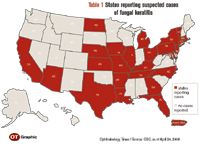Article
Treat as bacterial infection until fungus is positive, experts say
Pittsburgh-U.S. health officials are recommending thatophthalmic professionals who see patients with microbial keratitisshould consider whether it might be caused by the Fusarium fungus,rather than assume it is a bacterial infection as they might havein the past.
Pittsburgh-U.S. health officials are recommending that ophthalmic professionals who see patients with microbial keratitis should consider whether it might be caused by the Fusarium fungus, rather than assume it is a bacterial infection as they might have in the past.

Francis S. Mah, MD, said the bacterial infection progresses very quickly, and can cause more damage to a patient's eye in a shorter time than the fungal variety.

"If everyone were to say 'it's a fungus' and patients were not placed on an antibiotic, then in the patient with pseudomonas, for example, a hole could be in the eye in 12 to 24 hours," he said. "Whereas with a fungus, even though it's a difficult bug to kill and a bad infection, it probably isn't going to cause a hole in the eye in 24 hours.
"People have to be aware, people have to be notified of the fungal outbreak, and be concerned about it . . . but the majority of contact lens-associated infections are still probably going to be bacterial and we should treat them as bacterial infections until we get confirmation from a culture, or a patient does not respond (to antibiotics), or there are unusual characteristics," Dr. Mah added.
Dr. Mah recommended starting patients on an antibiotic such as moxifloxacin HCl ophthalmic solution 0.5% (Vigamox, Alcon Laboratories) or gatifloxacin 0.3% (Zymar, Allergan) every hour. If the corneal ulcer is larger than 2 mm or in the central visual axis, or if it has feathery edges, satellite lesions or looks abnormal, he suggested adding fortified cefazolin and culturing the infection for both bacteria and fungus.
"Most clinicians treat with antibiotics, and if the patients don't respond in a reasonable period, they do a culture, or refer the patient to a cornea specialist," Dr. Mah said. "With this outbreak, if there's anything unusual about the ulcer or the response to a therapy, the clinician should go ahead and culture or refer the patients earlier because, definitely, the patients who are doing better are those that are being identified and treated earlier."
Patients are reporting symptoms of sudden blurred vision, unusual redness, eye pain, excessive tearing or discharge, or increased light sensitivity, according to a statement issued by the American Academy of Ophthalmology.
Ophthalmologists encountering patients with these symptoms should take a corneal scraping, using an agar plate that promotes the growth of fungi, such as a brain-heart infusion (BHI) agar or a Sabouraud agar, or, if those are not available, a blood agar, recommended Eduardo C. Alfonso, MD, professor of ophthalmology and Edward W.D. Norton Chair in Ophthalmology, Bascom Palmer Eye Institute, University of Miami School of Medicine, Miami.
Regardless of the choice of agar, the culture must be kept at room temperature, and most fungi will grow within 3 days, Dr. Alfonso said.




